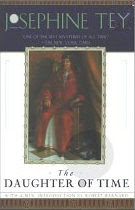Royalty Rules Challenge #1
 Scotland Yard detective Alan Grant fell through a trapdoor while chasing a suspect. Now the only thing he’s pursuing is something to counteract the boredom of being trapped in a hospital bed at the mercy of the nurses. His friend Marta comes to the rescue with the suggestion that he find a historical mystery to look into - did the Dauphin escape the guillotine? Was Amy Robsart murdered? - and, knowing Grant’s fascination with faces, brings along a selection of portrait prints to help him decide. None of the proffered puzzles captures his attention, but one face does: That of Richard III.
Scotland Yard detective Alan Grant fell through a trapdoor while chasing a suspect. Now the only thing he’s pursuing is something to counteract the boredom of being trapped in a hospital bed at the mercy of the nurses. His friend Marta comes to the rescue with the suggestion that he find a historical mystery to look into - did the Dauphin escape the guillotine? Was Amy Robsart murdered? - and, knowing Grant’s fascination with faces, brings along a selection of portrait prints to help him decide. None of the proffered puzzles captures his attention, but one face does: That of Richard III.
Marta had intended that Grant consider investigating whether Perkin Warbeck was, as he claimed, one of the Princes in the Tower - the two boys murdered by their usurping, hunchbacked uncle. Instead he begins researching Richard himself. Aided by an American historian (also provided by Marta), Grant sifts through the accounts of Richard’s reign. He soon realises that there is another mystery attached to Richard - that of whether he ordered the deaths of his nephews at all.
Once upon a time, I believed. I accepted without question what history and the encyclopaedia said: That Richard III was a cruel man who had two children killed that he might be king. When the first faint doubts appeared, I’m not sure. Perhaps when we read Richard III in Year 10 English, and it occurred to me that of course Shakespeare’s Richard was a monster; he was, after all, writing in the reign of Henry Tudor’s granddaughter at a time when theatres needed royal approval. Sometime later, I read that far from being hunchbacked, he was actually accounted good-looking. And everything I’ve read about Richard since has only served to improve my opinion of him. Yes, I was willing to be persuaded; but I think even someone convinced of his villainy would be given a lot to think about while reading this book.
As literature, it’s possessed of a noticeable shortcoming; the characters who come and go from Grant’s room (staff and visitors alike) are plainly there for the purpose of presenting the arguments for and against Richard, and voicing the popular legends. It’s potentially controversial history converted to a more palatable form, fiction. (And it reminded me of Colin Dexter’s The Wench is Dead, in which Morse solves a - fictional - nineteenth-century mystery while hospitalised.) In spite of its transparency, it’s still an engrossing read, such is the fascination of the information it presents. Grant’s emerging belief in Richard’s innocence is given weight by the discussion of other famous (non)incidents, like the Boston Massacre - in which the British troops were provoked and the dead could be counted on one hand. It’s a touch frightening to think how easily history can be completely rewritten without anyone saying a word, as well as a valuable reminder to think about ‘facts’, instead of just swallowing them. Some of the evidence in Richard’s favour is so obvious I can’t believe I hadn’t noticed it myself; some was an education. By the time it was all laid out, I couldn’t see how Richard could possibly be guilty - unless possessed of far less by way of brains than history would suggest.
As for Grant’s identification of the real villain ... that, I’m not so sure about. There’s no shortage of other suspects; and no real proof against the one Grant settles on. To find a truly convincing case against any one of them would likely take someone with degrees in history and psychology, and unfettered access to the original records - and probably the miraculous discovery of some long-lost documents, too.
And although I have none of those things ... if I were in London, I’d be sorely tempted to rush out to the British Library and begin the search myself.
Rating: A-

















This is one of my favourites of all the books that try to answer the Richard III question - did he or didn't he??
ReplyDeleteAn intriguing way to present a historical argument, I have to admit.
ReplyDeleteHere's a historical figure I would like to learn more about. This book sounds both informative and entertaining. Thanks for your review.
ReplyDeleteAh, yes, one of my favorites. I didn't worry about the contrived-ness of the visitors presenting evidence pro and con because it was so much fun trying to solve an historical mystery along with Inspector Grant.
ReplyDeleteSharon Penman writes about Richard in The Sunne in Splendor and fingers a different villain. You might enjoy that one. Review here:
http://www.semicolonblog.com/?p=1230
I followed you here from Semicolon. A Shakespear prof of mine once said that while it was an entertaining book, it seemed as if the author had an axe to grind. I thought that was a good "grain of salt" to add to the read.
ReplyDeleteI became interested in Richard III when I read Sharon Kay Penman's "The Sunne in Splendour." I was half way through the book before I realized that they were talking about the same Richard III of Shakespear's play. He is the one who has shaped the modern view of Richard. Penman's book sparked my curiosity about the real Richard and Tey's book helped me to start putting it all together. Her vehicle for the argument is fantastic and I enjoyed it immensely. SeattleRainyDayBookBlog.blogspot.com
ReplyDeleteI love Josephine Tey's book about Richard III. I read it many years ago after Sharon Kay Penman's "The Sunne in Splendour." When I was half way through Penman's book I suddenly realized that she was talking about the same Richard III that Shakespeare wrote about. That play has shaped the modern view of Richard and so reading "Splendour" was an eye opener. It sparked my interest so much that I read many books about Richard after that including "The Daughter of Time." I've actually visited Middleham castle amd have a small piece of it's walls in my bookcase. SeattleRainyDayBookBlog.blogspot.com
ReplyDelete